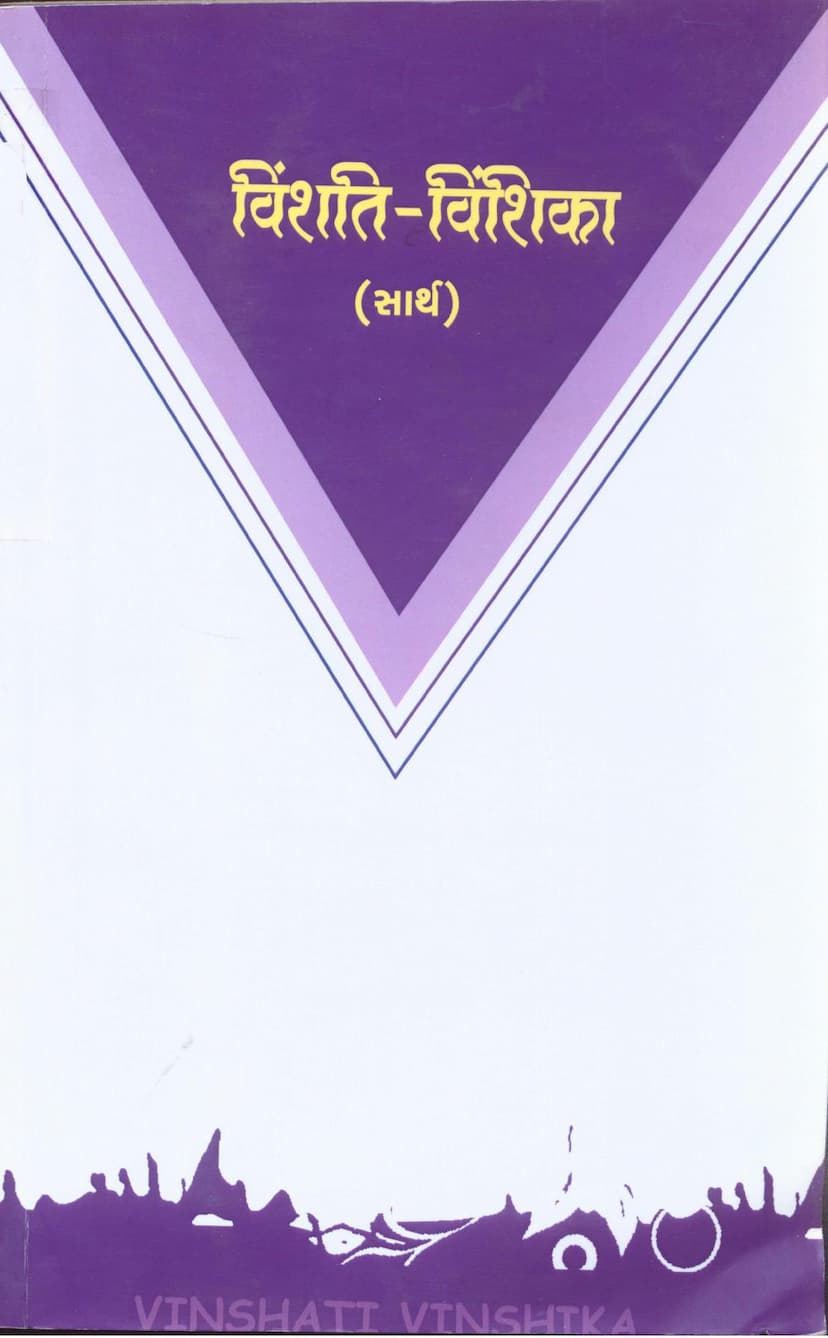Vinshati Vinshika Sarth
Added to library: September 2, 2025

Summary
This document is a scanned copy of the Jain text "Vinshati Vinshika Sarth" (with commentary). Here's a summary of its contents based on the provided pages:
Book Title: Vinshati Vinshika Sarth (विंशति-विशिका सार्थ)
Author(s): Acharya Shrimad Vijay Haribhadrasuri (original Prakrit text), compiled by Pt. Shrimad Vijay Kantivijayji Ganivar, collected by Acharya Shrimad Vijay Hembhushansurishwarji Maharaj, edited by Acharya Shrimad Vijay Chandrabhooshansurishwarji Maharaj.
Publisher: Paramshreddhay Prakashan, Ahmedabad.
Core Text: Vinshati Vinshika (विंशति-विंशिका)
- The text is a compilation of 20 "Vishikas" (sections or chapters), each dealing with a specific topic.
- It is an essence of Jain scriptures, summarizing important subjects in just 20 verses (Shlokas) for each Vishika.
- The original text is in Prakrit, with a Sanskrit translation (Chhaya-Arth) provided.
- The author, Acharya Haribhadrasuri, was a highly prolific scholar who composed 1444 texts. Many were lost due to calamities and invasions. This "Vinshati Vinshika" is one of the surviving valuable works, described as "Sagar in a pitcher" (गगर में सागर - condensing vast knowledge into a small space).
Key Contributors and Background:
- Paramshreddhay Prakashan: Established in memory of Acharya Shrimad Vijay Hembhushansurishwarji Maharaj, a respected leader and disciple of Acharya Shrimad Vijay Ramchandrasurishwarji Maharaj. The publication aims to preserve and disseminate Jain literature.
- Acharya Shrimad Vijay Haribhadrasuri: The original author, a highly learned scholar who lived in a period where the knowledge of earlier texts (Purvas) was becoming fragmented. He was known for his wisdom and comprehensive works.
- Pt. Shrimad Vijay Kantivijayji Ganivar: The compiler, who noted down the text for his personal study.
- Acharya Shrimad Vijay Hembhushansurishwarji Maharaj: The collector, who preserved Kantivijayji's notes. He was a significant figure in the Tapa Gachchha tradition.
- Acharya Shrimad Vijay Chandrabhooshansurishwarji Maharaj: The editor, who brought the text to light.
- Munishri Vinaybhushan Vijay: The inspiration for publishing the compiled work.
- Various Munis and Sadhvis: Contributed to the purification, proofreading, and overall compilation of the text.
- Shri Jinagna Aradhak Shwetambar Murtiupujak Sangh (Mithakhali - Ahmedabad): Supported the publication as a beneficial use of knowledge funds.
Content Overview of the 20 Vishikas (from Page 21-22): The book covers a wide range of Jain philosophical and practical topics, with each Vishika focusing on a specific subject:
- Adhikara Vishika (अधिकार-विंशिका): Introduction and indication of the topics to be covered in the subsequent Vishikas.
- Loka-Anaditva Vishika (लोक-अनादित्वविंशिका): The eternal and beginningless nature of the universe and the five existent substances (Panchastikayas).
- Kul-Niti and Loka-Dharma Vishika (कुलनीति और लोकधर्म विशिका): Social customs, traditions, and worldly duties that are often based on lineage and societal norms.
- Charam-Pudgal-Paravart Vishika (चरमपुद्गलपरावर्त विशिका): The concept of the final cycle of transmigration (Pudgala Paravart) and its significance.
- Samyaktva - Beej-adi Vishika (सम्यक्त्व – बीजादिविंशिका): The foundational seeds and initial stages of Right Faith (Samyaktva).
- Samyaktva - Dharma Vishika (सम्यक्त्व – धर्मविंशिका): The practice and characteristics of Right Faith (Samyaktva) and its associated virtues.
- Dana Dharma (दान धर्म): The principles and types of charity.
- Puja Dharma (पूजा धर्म): The significance and methods of worship.
- Shravak Dharma Vishika (श्रावक धर्मविंशिका): The duties and conduct of a lay follower (Shravak).
- Shravak Pratimao (श्रवकी प्रतिमाओ): The progressive stages of spiritual development for a lay follower, known as vows or vows of progress (Pratimas).
- Yati Dharma (यति धर्म): The vows and conduct of an ascetic (Yati).
- Yati Shiksha (यति शिक्षा): The teachings and discipline for ascetics.
- Bhiksha Vidhi Vishika (भिक्षाविधि विशिका): The rules and ethics of alms-begging for ascetics.
- Bhiksha-Antaraya-Shuddhi Vishika (भिक्षांतरायशुद्धिविशिका): The purification from obstacles and impurities related to alms-begging.
- Alochanā Vishika (आलोचनाविंशिका): The practice of self-criticism and confessing faults to a spiritual guide.
- Prayashchitta Vishika (प्रायश्चित्तविंशिका): The penances and atonements for transgressions.
- Yoga Vishika (योग विशिका): The practices of spiritual discipline and meditation.
- Kevala-Gnāna (केवलज्ञान): The nature and characteristics of Omniscience.
- Siddha-Vibhukti Vishika (सिद्धविभक्ति विशिका): The different classifications or manifestations of liberated souls (Siddhas).
- Siddha-Sukh Vishika (सिद्धसुख विशिका): The supreme and blissful state of liberated souls.
Editorial and Publication Notes:
- The publication is dedicated to the memory of Acharya Shrimad Vijay Hembhushansurishwarji Maharaj.
- The foreword (Prakashkiya) and editorial (Sampadakiya) provide details about the founding of Paramshreddhay Prakashan, the lineage of the gurus involved, and the significance of the "Vinshati Vinshika" as a valuable scripture.
- The editorial emphasizes Haribhadrasuri's ability to condense profound spiritual truths into a concise format.
- Special thanks are given to Rajiv Trading Co. for printing and Mahendrabhai Lodrawala on behalf of Paramshreddhay Prakashan.
- The editor acknowledges the help of various monks and nuns in the process.
- The text also highlights Acharya Haribhadrasuri's clarity in refuting other religious views and establishing the purity of the Svetambara path established by Lord Mahavir.
- The publication is being released during the reign of Acharya Shrimad Vijay Punyapal Sureshwarji Maharaj.
Overall Purpose: The "Vinshati Vinshika Sarth" aims to provide readers with a systematic and accessible understanding of key Jain principles, presented by the renowned Acharya Haribhadrasuri and brought to the public through the dedicated efforts of scholars and patrons of Jain literature. It serves as a guide for spiritual practice and understanding the path to liberation.